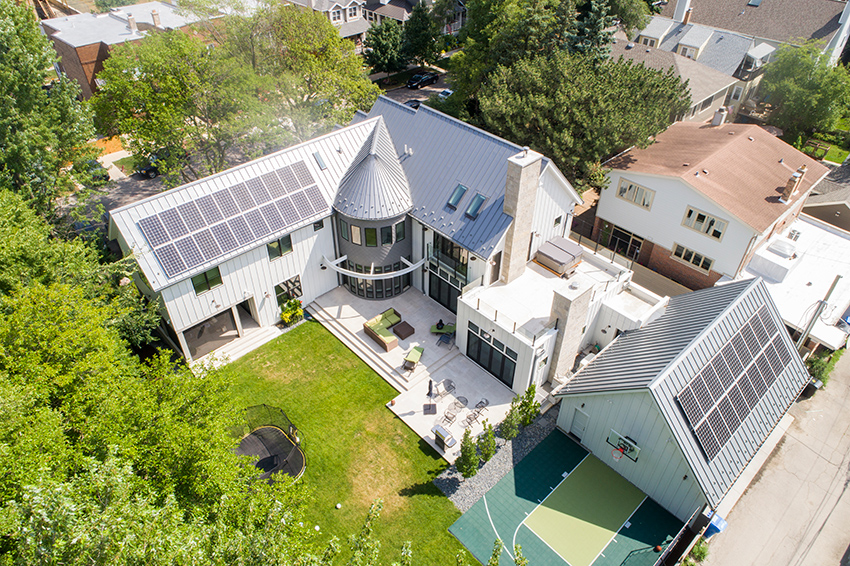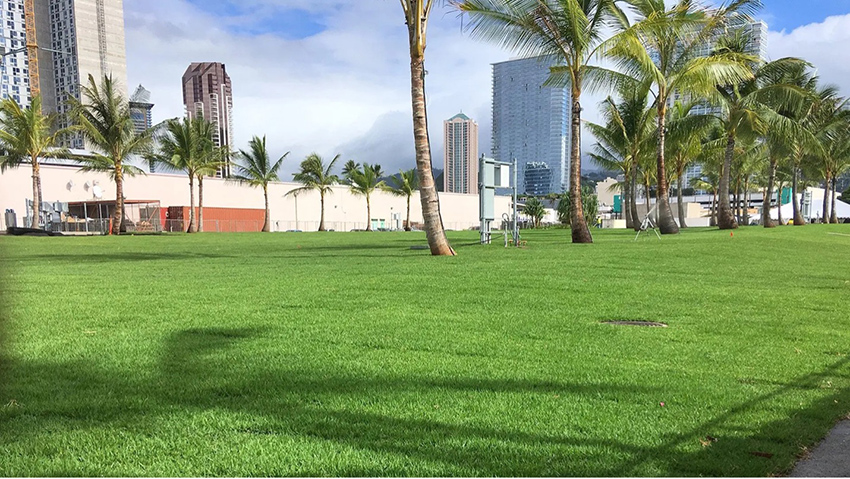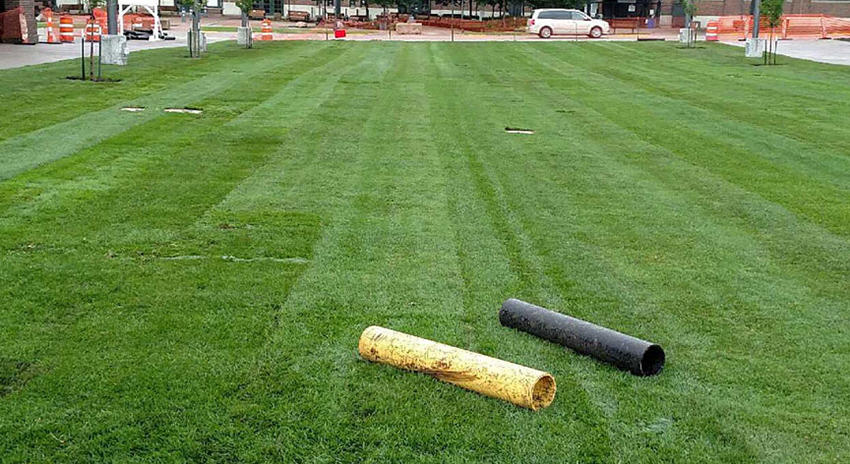This CE Center article is no longer eligible for receiving credits.
When sustainability is mentioned, energy use or efficiency may be the corollary terms that spring to mind. Or,
perhaps, green products or certification systems. Each of these terms capture an element of sustainability, but not
the whole landscape. So, where are the new frontiers of sustainability?
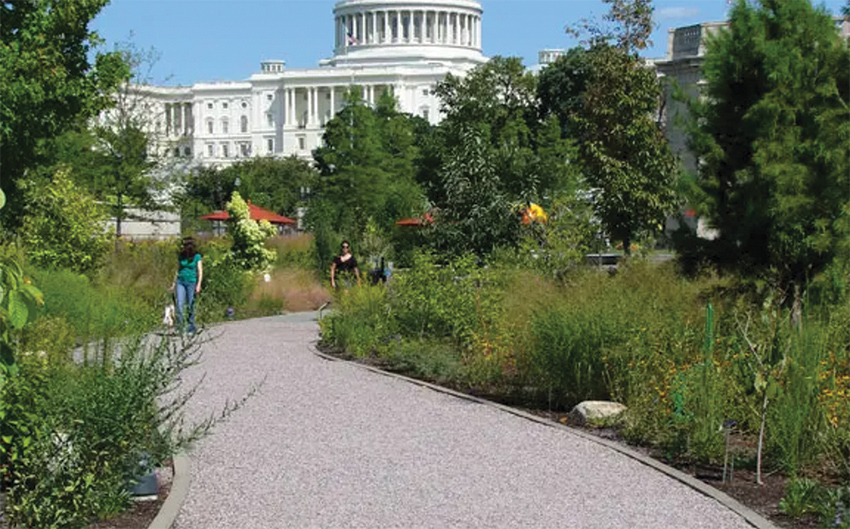
Photo courtesy of Invisible Structures
A beautiful and porous surface was added to the U.S. Botanic Garden grounds in Washington,
D.C., by the Architect of the Capitol, who wanted the sound and feel of gravel, but needed ADA compliance for
all visitors. The porous surface eliminates runoff and stormwater threats that occur in urban areas.
In 1987, the United Nations Brundtland Commission defined sustainability as “meeting the needs of the present without
compromising the ability of future generations to meet their own needs.”
Therefore, to pursue sustainability is to create and maintain the conditions under which humans and nature can exist
in productive harmony to support present and future generations. Under this lens, sustainability embraces the
concept that “goods and services should be produced in ways that do not use resources that cannot be replaced and
that do not damage the environment” (U.S. Environmental Protection Agency).
As the building industry has rapidly advanced to embrace sustainability’s performance objectives, the boundaries of
what products and structures are capable of have also expanded. Across all spectrums, there are breakthrough
technologies and applications providing design professionals and their projects the ability to force outward the
assumed limitations of the built environment. These advances touch all phases of a project, from its inception to
its end.

Photo courtesy of Kipnis Architecture + Planning
Reaching 2030 net-zero goals means providing the tools that calculate sustainability targets
to every design professional and every project.
BEGINNING WITH SUSTAINABILITY
Too often, being at the cutting edge is only attributed to large corporations, multinational firms, or to unique
individuals with limitless financial resources. Small architectural firms specializing in residential projects may
believe that they have neither the capacity nor the resources to promote and design groundbreaking sustainable
buildings. Yet, they have the desire–and the essential belief–to move their product toward, and to see the entire
housing market achieve, net zero as quickly as possible, meeting 2030 goals.
Today’s technologies are facilitating a wide range of ways that design professionals and architects, in any size
practice, can inject sustainable principles into their projects before they ever launch beyond a computer. BIM
software allows architects to sketch, model, and document their projects in a fully integrated workflow. The data
that is included in the model can be used to quantify, analyze, and visualize sustainable insights into the plan and
make smart design decisions. These programs can effectively produce automatic reports, accurate quantity takeoff
calculations, and schedules, including carbon assessment calculations. Integrating energy analysis in early stages
of the design enables designers to assess energy performance and can be updated as the design progresses. This
analysis can be configured to match performance goals or certification standards. Such tools also provide the means
to more accurately communicate with clients, integrating them into the process.
Architectural design excellence does not have to be sacrificed for principles of sustainability. By incorporating
BIM software applications from the very start of a project, 'net zero' becomes a reality. Advanced software also
ensures that practicing the architectural design philosophy of “high design and low carbon” need not be limiting.
Selecting the path of sustainable design expands the possibilities for innovative architectural forms, construction
methods, and use of materials, including the architectural integration of passive solar and bioclimatic design.
SUSTAINABILITY IN THE MIDDLE
How can sustainability be enhanced for an existing project? Can an entire street or city shift towards greater
sustainability as it stands? Growing populations and an upsurge of natural disasters are increasing the strain on
urban areas across the United States. Addressing these concerns was the genesis of Urban Resilience. Urban
Resilience is the idea that cities can be built, or altered, in situ to better prepare and navigate these issues.
Sustainable infrastructure and adaptable ecological systems can contribute to more resilient cities. Focusing on how
infrastructure and ecological factors interact can give urban areas the ability to absorb, recover, and prepare for
future shocks.
While changing the infrastructure in an existing urban development is not always possible, adding components which
can aide in handling these disasters is achievable. There are a number of ways in which cities can assess their
risks and better prepare for inevitable weather events.
In cities with storm and flooding risks, stormwater management is amongst the most important ways to build
resilience. Most cities now use municipal separate storm sewer systems (MS4s). These are networks of ditches, curbs,
gutters, sewer pipes, and outfalls solely dedicated to moving runoff from the city and into natural waterways that
carry it away. However, in the event of extreme rainfall these MS4 waterways are not equipped to manage the deluge
of water. Additionally, there is no method of pollution containment; pollutants from the streets are simply washed
into the waterways. Some cities have added concrete to the inside of channels to increase the water flow, but this
diminishes the natural beauty of the landscape and does not address removal of pollutants from the water.
Many municipalities are now requiring developers to add retention and detention ponds, which help with the initial
impact of rainwater and release it slowly back into the waterways. While these are helpful in areas of new
development, they are not always easy to add in existing urban areas.
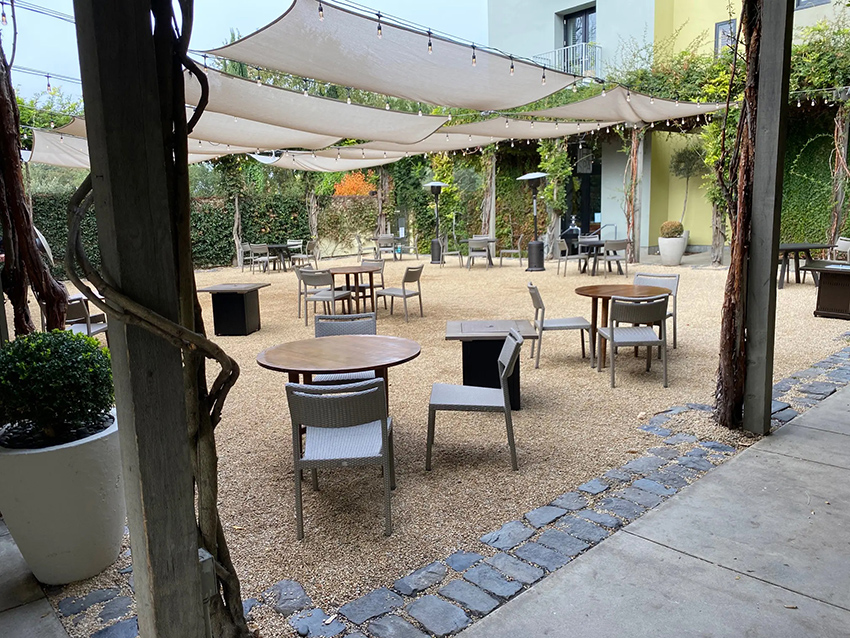
Photo courtesy of Invisible Structures
To expand its outdoor seating, this Healdsburg, Calif., hotel converted a grass area to a
patio. The finished result create a clean, easy to maintain, ADA-accessible area.
Low-impact solutions are gaining ground to address both stormwater concerns and meet municipal requirements. These
include rain gardens, vegetated rooftops, rain barrels, underground storage systems, and porous paving. Of these
strategies, underground storage systems and porous paving can have the highest immediate impact on the effects of
rainwater runoff, especially when used together. Surfaces that are pervious can absorb water and send it back into
the earth to recharge ground water and filter out pollutants. Porous concrete, porous asphalt, ridged plastic
pavers, and flexible plastic pavers transform surfaces, traditionally created from impervious materials, into
functional areas that also serve to aide in stormwater mitigation.
Pedestrian paths, parking lots, and fire lanes can all be designed using porous paving, creating areas around
buildings that will drain water instead of pooling it or sending runoff to other areas.
Underground water storage can be added beneath functional porous surfaces to increase flow, naturally filter out
toxins, and contain water beneath the surface.
Taking a careful look at what material surrounds a project can engender a huge leap forward in its sustainability.
These new products also address increasing the resilience of cities without demolishing existing structures.
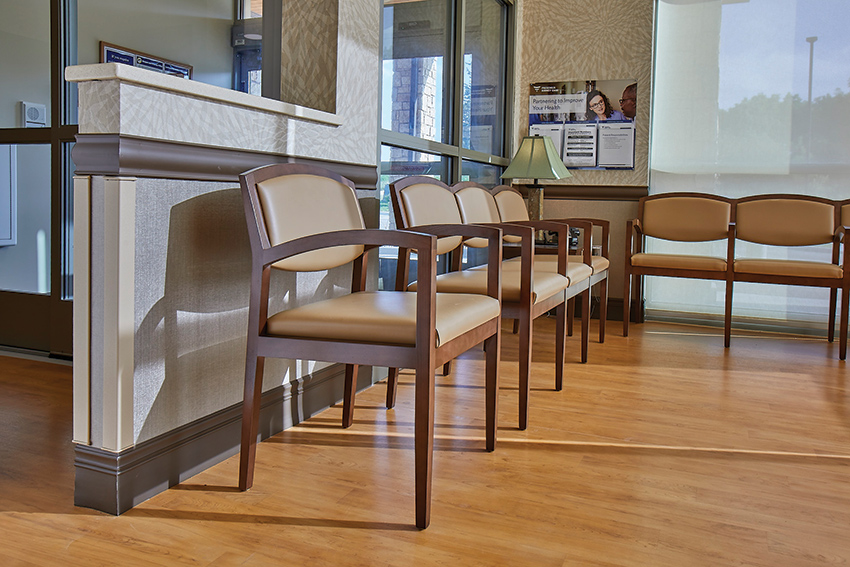
Photo courtesy of Inpro
The aesthetic appearance of a facility can be extended through smart selection of products,
including choosing high-wear items that are recyclable at their end of service.
When sustainability is mentioned, energy use or efficiency may be the corollary terms that spring to mind. Or,
perhaps, green products or certification systems. Each of these terms capture an element of sustainability, but not
the whole landscape. So, where are the new frontiers of sustainability?

Photo courtesy of Invisible Structures
A beautiful and porous surface was added to the U.S. Botanic Garden grounds in Washington,
D.C., by the Architect of the Capitol, who wanted the sound and feel of gravel, but needed ADA compliance for
all visitors. The porous surface eliminates runoff and stormwater threats that occur in urban areas.
In 1987, the United Nations Brundtland Commission defined sustainability as “meeting the needs of the present without
compromising the ability of future generations to meet their own needs.”
Therefore, to pursue sustainability is to create and maintain the conditions under which humans and nature can exist
in productive harmony to support present and future generations. Under this lens, sustainability embraces the
concept that “goods and services should be produced in ways that do not use resources that cannot be replaced and
that do not damage the environment” (U.S. Environmental Protection Agency).
As the building industry has rapidly advanced to embrace sustainability’s performance objectives, the boundaries of
what products and structures are capable of have also expanded. Across all spectrums, there are breakthrough
technologies and applications providing design professionals and their projects the ability to force outward the
assumed limitations of the built environment. These advances touch all phases of a project, from its inception to
its end.

Photo courtesy of Kipnis Architecture + Planning
Reaching 2030 net-zero goals means providing the tools that calculate sustainability targets
to every design professional and every project.
BEGINNING WITH SUSTAINABILITY
Too often, being at the cutting edge is only attributed to large corporations, multinational firms, or to unique
individuals with limitless financial resources. Small architectural firms specializing in residential projects may
believe that they have neither the capacity nor the resources to promote and design groundbreaking sustainable
buildings. Yet, they have the desire–and the essential belief–to move their product toward, and to see the entire
housing market achieve, net zero as quickly as possible, meeting 2030 goals.
Today’s technologies are facilitating a wide range of ways that design professionals and architects, in any size
practice, can inject sustainable principles into their projects before they ever launch beyond a computer. BIM
software allows architects to sketch, model, and document their projects in a fully integrated workflow. The data
that is included in the model can be used to quantify, analyze, and visualize sustainable insights into the plan and
make smart design decisions. These programs can effectively produce automatic reports, accurate quantity takeoff
calculations, and schedules, including carbon assessment calculations. Integrating energy analysis in early stages
of the design enables designers to assess energy performance and can be updated as the design progresses. This
analysis can be configured to match performance goals or certification standards. Such tools also provide the means
to more accurately communicate with clients, integrating them into the process.
Architectural design excellence does not have to be sacrificed for principles of sustainability. By incorporating
BIM software applications from the very start of a project, 'net zero' becomes a reality. Advanced software also
ensures that practicing the architectural design philosophy of “high design and low carbon” need not be limiting.
Selecting the path of sustainable design expands the possibilities for innovative architectural forms, construction
methods, and use of materials, including the architectural integration of passive solar and bioclimatic design.
SUSTAINABILITY IN THE MIDDLE
How can sustainability be enhanced for an existing project? Can an entire street or city shift towards greater
sustainability as it stands? Growing populations and an upsurge of natural disasters are increasing the strain on
urban areas across the United States. Addressing these concerns was the genesis of Urban Resilience. Urban
Resilience is the idea that cities can be built, or altered, in situ to better prepare and navigate these issues.
Sustainable infrastructure and adaptable ecological systems can contribute to more resilient cities. Focusing on how
infrastructure and ecological factors interact can give urban areas the ability to absorb, recover, and prepare for
future shocks.
While changing the infrastructure in an existing urban development is not always possible, adding components which
can aide in handling these disasters is achievable. There are a number of ways in which cities can assess their
risks and better prepare for inevitable weather events.
In cities with storm and flooding risks, stormwater management is amongst the most important ways to build
resilience. Most cities now use municipal separate storm sewer systems (MS4s). These are networks of ditches, curbs,
gutters, sewer pipes, and outfalls solely dedicated to moving runoff from the city and into natural waterways that
carry it away. However, in the event of extreme rainfall these MS4 waterways are not equipped to manage the deluge
of water. Additionally, there is no method of pollution containment; pollutants from the streets are simply washed
into the waterways. Some cities have added concrete to the inside of channels to increase the water flow, but this
diminishes the natural beauty of the landscape and does not address removal of pollutants from the water.
Many municipalities are now requiring developers to add retention and detention ponds, which help with the initial
impact of rainwater and release it slowly back into the waterways. While these are helpful in areas of new
development, they are not always easy to add in existing urban areas.

Photo courtesy of Invisible Structures
To expand its outdoor seating, this Healdsburg, Calif., hotel converted a grass area to a
patio. The finished result create a clean, easy to maintain, ADA-accessible area.
Low-impact solutions are gaining ground to address both stormwater concerns and meet municipal requirements. These
include rain gardens, vegetated rooftops, rain barrels, underground storage systems, and porous paving. Of these
strategies, underground storage systems and porous paving can have the highest immediate impact on the effects of
rainwater runoff, especially when used together. Surfaces that are pervious can absorb water and send it back into
the earth to recharge ground water and filter out pollutants. Porous concrete, porous asphalt, ridged plastic
pavers, and flexible plastic pavers transform surfaces, traditionally created from impervious materials, into
functional areas that also serve to aide in stormwater mitigation.
Pedestrian paths, parking lots, and fire lanes can all be designed using porous paving, creating areas around
buildings that will drain water instead of pooling it or sending runoff to other areas.
Underground water storage can be added beneath functional porous surfaces to increase flow, naturally filter out
toxins, and contain water beneath the surface.
Taking a careful look at what material surrounds a project can engender a huge leap forward in its sustainability.
These new products also address increasing the resilience of cities without demolishing existing structures.

Photo courtesy of Inpro
The aesthetic appearance of a facility can be extended through smart selection of products,
including choosing high-wear items that are recyclable at their end of service.
FULL CIRCLE: SUSTAINABILITY AT THE END
The overall condition of a facility speaks volumes not only to those who live and work there, but also to visitors
and potential users. The old adage still rings true: You only get one chance to make a good first impression.
To maximize a sustainable life cycle, everyone responsible for the longevity of a new building– architects, interior
designers, contractors, building owners, and facility staff–should take a long-term view when it comes to choice of
products. That means focusing not only on the performance of selected products, but also addressing the final
destination for those products when they reach their end of service. Instead of simply sending scrap to a landfill,
leading manufacturers are able to reuse old material in ways that create usable products with greater performance.
Industry manufacturing leaders have a goal to be Zero Waste by 2025. This goal includes the ability to repurpose any
internal scrap. Company and product transparency can be gauged by examining manufacturers through documentation such
as a Health Product Declarations (HPD), Environmental Product Declarations (EPD), and Greenguard Gold Certificates.
Gathering the information to deliver these documents also sheds a light on the environmental aspects of products at
various stages. This information helps hone sustainable decision making and future planning.
Those businesses implementing a more robust recycling program allow manufacturers to increase product yields and
produce less scrap. Often, manufacturers recognize recycling gains from an overall diversion rate based on
production efficiencies, and internal recycling of PVC, metals, and comingled materials. Increasingly, manufacturers
are launching recycling initiatives on the consumer side to accelerate progress toward waste reduction goals.
Many states offer incentives for local manufacturers to recycle. The Green Tier program is a recognition and
partnership program between Wisconsin businesses, trade associations, communities and non-profits, and the
Department of Natural Resources (DNR). Green Tier was the first program of its kind in the country and serves as a
model for others. It is based on recommendations from an advisory committee representing a wide array of business
sectors, industry councils, municipalities, and environmental organizations. It also builds on the successes of the
Environmental Cooperation Pilot Program, which the DNR launched in 1998 to offer participating companies the
opportunity to pursue environmental initiatives that would not have been possible under traditional regulations.
Green Tier is designed to encourage innovation, collaboration, and new environmental goal setting.
Green Tier 2, the newest phase of the Wisconsin program, is targeted at companies with an effective Environmental
Management System (EMS) and a history of superior environmental performance. Tier 2 participants represent truly
exceptional companies that are not only committed to going above and beyond but are also committed to bringing about
change in their industry, region, or within their supply chain.
“While the overall reductions are fantastic, for us the most exciting part of these results were the modifications
to our production processes that eliminated waste,” said Mark Alan, Inpro’s Senior Vice President of Product
Management and Development. “In other words, there was no scrap to divert because it was never created in the first
place. These process improvements amounted to 42.3 tons that never entered the waste stream.”
By taking ownership of a product’s pathway, from design all the way to the potential for reuse at disposal,
sustainability allows for the all-important recapture of goods and materials.
LEVERAGING SOFTWARE & TECHNOLOGY TO ACHIEVE SUSTAINABILITY GOALS
Cutting-edge advances in software allow architects and design professionals to futurecast and fine tune designs at
their earliest stages. Flexible, design-centric BIM solutions enable designers, whether in individual practice or at
a large firm, to express their creativity and allows for the expansion of innovative architectural forms,
construction methods, and use of materials.
Addressing Embodied Carbon
A unique focus of the embodied carbon calculator tool places a lens on the implications of a project’s embodied
carbon. Embodied carbon refers to the carbon emitted through the manufacturing and transport of a building's
materials as well as the building's assembly. Embodied carbon is responsible for about 11% of global CO2 emissions,
and that number is expected to rise.
Embodied carbon is different from operational carbon, which is generated from in-use operations like heating,
cooling, lighting, and ventilation. While operational carbon can be reduced after a building is constructed,
embodied carbon is locked into the structure as it is built. It is “embodied” in the building itself.
Because embodied carbon is a fixed number that is based upon materials used, monitoring of that factor is crucial.
For architects, targeting net-zero carbon means that analyzing projects’ environmental footprints is more important
now than ever. To account for and offset embodied carbon within a design, BIM software applications create a way to
calculate embodied carbon throughout the entire life cycle of a project. These programs feature an embodied carbon
calculator. The tool has a pre-formatted worksheet that has built-in formulas to calculate material embodied carbon
emissions based on designer inputs.
An embodied carbon calculator is organized into columns corresponding to stages of the project’s life cycle:
- Product Stage: for tracking embodied carbon emitted from supply, transport, and manufacturing of selected
raw materials.
- Transportation Stage: for tracking carbon emitted from the transportation of products from the
manufacturing plant to the project site.
- Construction Stage: for tracking carbon emitted from any on- or offsite construction-related activities.
- Replacement Stage: for tracking carbon emissions associated with anticipated replacement of building
components.
- Deconstruction & Demolition Stage: for tracking carbon emissions arising from any on- or offsite
deconstruction and demolition activities.
- Recovery/Recycling Stage: for tracking carbon emissions associated with treatment and processing of
materials and components that’re intended to be recovered and reused after the end of the built asset’s life
cycle.
- Disposal Stage: for tracking carbon emissions arising from disposal of materials and components not
expected to be recovered and repurposed, but rather to be incinerated or disposed of at a landfill.
Algorithms-aided design tools enable designers to extract data from the embodied carbon calculator and visualize it as a
chart. When coupled with tools used to calculate energy demand, design professionals are set up to complete a holistic
carbon emissions assessment.
Colin Davis of Studio Partington in London, an early adopter of embodied carbon tools, said: “Studio Partington is
passionate about designing buildings that take a conscious effort to minimize their impacts on the environment. The
awareness of embodied carbon and the contribution it makes to a building’s overall carbon footprint is a new field to
all designers. The embodied carbon calculator gives us the opportunity, from the earliest stages of a project, to
quickly understand and analyze the amount of material and likely embodied carbon impacts of our proposals. This can feed
back into the design process to lead to better and more responsible solutions.”
From the Software to the Strategies: Reducing Embodied Carbon in Projects
Embodied carbon calculators demonstrate the effectiveness of certain strategies to reduce a project’s embodied carbon
levels.
First among embodied carbon reduction approaches is the re-use of buildings instead of constructing new ones.
Construction processes have a high carbon footprint. Renovating what is already there, instead of tearing everything
down and starting over, can greatly reduce a project’s embodied carbon levels. A renovation project still allows for
design creativity at virtually the same level as with a ground-up build.
Second, it is important to limit use of high-carbon materials like plastic, concrete, and metal. Wood is growing
more and more popular as a building material due to its lower embodied carbon levels. Use of recycled materials is
crucial. Especially for high-carbon materials like aluminum, recycling can greatly reduce a project’s embodied
carbon, because the carbon required to manufacture those materials has already been accounted for.
To avoid accruing unnecessary carbon, source materials locally. Instead of having materials shipped from overseas,
for example, look to source product from the immediate area. This reduces carbon emissions from lengthy
transportation.
Modular systems also can reduce embodied carbon numbers. Modular structures are easier and faster to construct,
reducing carbon emissions generated from the construction process.
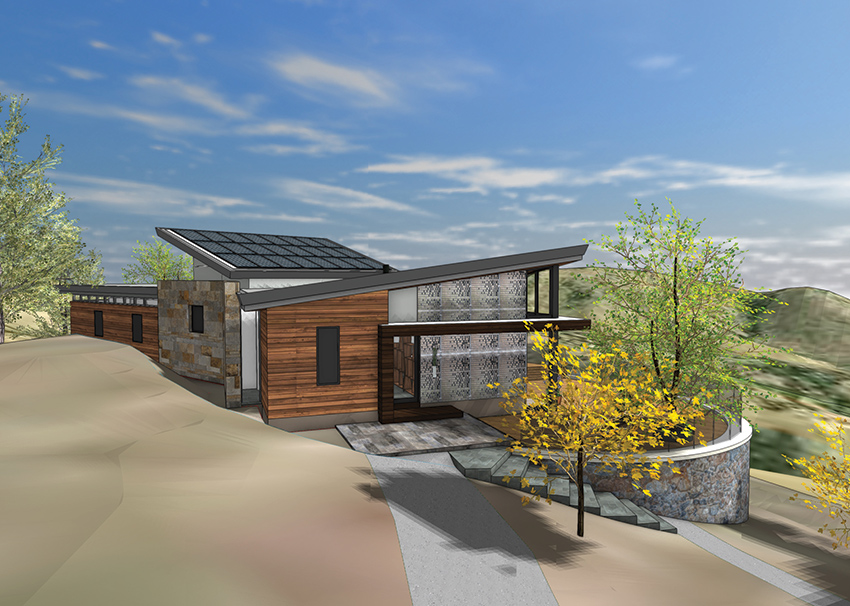
Photo courtesy of Kipnis Architecture + Planning
Flexible design-centric BIM solutions enable designers to fine-tune designs at their earliest
stages.
Putting it all Together
With powerful reporting capabilities and parametric tools available today with BIM software, design professionals can
assess energy performance in early stages of the design. Besides providing data, flexible design-centric BIM
software also frees architects to experiment with beautiful design. The technology enables art and sustainability to
work together, rather than to hinder each other.
“I remember right before I went to architecture school, I used to read Popular Science magazines, and they would
show this new thing, really amazing solar-powered homes! But honestly, they were terribly ugly,” recalls Nathan
Kipnis, FAIA. “So, in school, I thought about the fact that no one is going to want an efficient home if they
weren’t also well-designed and attractive. And to me, that is what architecture is all about - Art + Technology.
Making something that performs how it needs to, but also designing it well. This is how architects are going to get
the general public to demand these buildings. It’s not hard to get leading-edge clients to get on board with
sustainable and resilient design, but we want to get everyone craving these designs.”
CAPTURING SUSTAINABILITY–AND RESILIENCE–IN THE NOW
The number and cost of weather-related disasters are on the rise in the United States. According to the National
Centers for Environmental Information, there were a total of $22-billion-dollar disasters in 2020. The cost of these
events exceeded $95 billion in damages. Of these 22 events, 13 were related to severe storms.
Growing populations and a surge of natural disasters is placing increasing strain on urban areas across the country.
The pressure from stormwater events is especially hard on urban areas where the landscape and the population are
both dense. Although changing the infrastructure in an existing urban development is not always possible, adding
components which can aid in handling these disasters is now achievable. There are a number of ways in which cities
can assess their risks and better prepare for these inevitable events. Early alerts, community awareness, and
evacuation plans should all be in place, but adding components that prevent or manage the effects of these
occurrences also needs to be a priority.
Urban Resilience
From these concerns comes the movement towards Urban Resilience. Urban Resilience is the idea that cities can be
built or altered to better prepare and navigate these issues. Sustainable infrastructure and adaptable ecological
systems can give urban areas the ability to absorb, recover, and prepare for future shocks.
In the United States, the population in urban areas has increased from approximately 30% in the 1950s to 82% in
2020. Demographic models anticipate that this percentage will continue to grow. With the increase in both population
density and climate related disasters, it is important that tenets of Urban Resilience are considered in both
existing and new development. However, most major cities in the US were not designed to support these changes.
As a result, many municipalities are implementing, and even requiring, low impact solutions to better mitigate the
effects of stormwater and reduce pollutants in waterways. Among the requirements are standards mandating a certain percentage of porous surfaces in new development and for the retrofit of existing impervious surfaces. In order to
achieve these goals, design professionals tasked with this planning are opting to use permeable paving in areas that
have traditionally been paved over with concrete or asphalt.
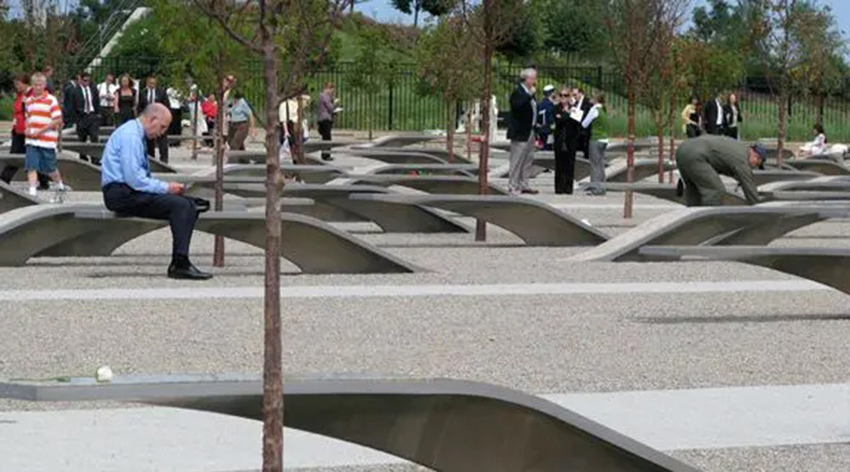
Photo courtesy of Invisible Structures
A view of the September 11 Pentagon Memorial in Arlington, Va. Memorial Units are meant to be
sat on, and the site is meant to be seen, heard, felt, and contemplated. Porous paving was used to promote the
growth of the trees in the gravel surface.
Permeable Paving
It is important to create surfaces that are pervious for several reasons. Permeable surfaces not only reduce flooding
risks, but they also facilitate absorption of water back into the earth. This absorption allows for natural
filtering out of pollutants and enhances recharging for ground water. By using permeable surfaces, urban areas can
decrease areas covered in impermeable concrete and asphalt and increase natural surfaces and green space.
Permeable Paving is a type of pavement or under-surface structure that supports the passage of rainfall or water
run-off through the surface and sub-surface below it. Permeable surface solutions are designed to support a heavy
load of traffic while also protecting the surface from compaction that would inhibit drainage. There are different
types of permeable paving: Concrete Paving Blocks, Porous Concrete or Asphalt, Rigid Plastic Porous Pavers, and
Flexible Plastic Porous Pavers. The functionality, flow rate, maintenance, and aesthetics of pavers varies with the
type of porous paver selected.
The use, weight, and frequency of traffic determine what type of paver can be used. Permeable Pavers can be designed
to host a wide range of traffic types; from pedestrian foot traffic, to residential parking, to emergency vehicles.
The depth of the base course beneath the pavers determines the weight the pavers can support. With an appropriate
base course, permeable pavers can far exceed H-20 loading (the design criteria of the American Association of State
Highway Transportation Officials) and have a psi rating of over 15,000.
Pedestrian paths, parking lots, and fire lanes can all be made using porous paving, creating areas around buildings
that will efficiently drain, instead of pooling water or creating runoff for other areas. Certain porous pavers,
such as ridged or flexible porous pavers, can be filled with aggregate or topped with grass. These pavers add green
space to a design, converting an otherwise single purpose area into a multifunctional space.
Selecting Among Porous Paving Types
What attributes make porous paving products different from one another? The paving structures themselves vary in
material, size, shape, compressive strength, and void space. The void space of any paver directly impacts flow rate
and how much drainage can occur.
While using any pervious material in place of an impermeable surface is an environmentally better choice, flexible
plastic pavers will produce the greatest impact during extreme rain events, making them the best option when
planning for urban resilience. Flexible plastic pavers have the greatest void space and thereby create the highest
flow rate. When used in conjunction with aggregate or grass, these pavers also offer the greatest environmental
benefits. Flexible plastic pavers can also be used in conjunction with underground storage systems for maximum
stormwater impact. Because natural bioremediation occurs when stormwater runs through the sand in gravel or grass
pavers, these systems provide the opportunity for water reuse, further increasing their sustainability. Pavers
filled with grass offer a long-term green paving alternative that can reduce CO2 emissions and filter out
environmental toxins through bioremediation. In fact, an acre of grass makes a better “carbon sink” than an acre of
trees and produces roughly four times the oxygen. Using pavers filled with aggregate or grass reduces both heat and
sound for the surrounding area. There are also cold weather benefits, as the air trapped in the pavement can store
heat and release it back to the surface, speeding the melting of snow and ice. Melted snow is recaptured as it
dissipates back through the pavers.
Not only do flexible plastic pavers create exceptional benefits for the environment in which they are placed, but
the product itself is also incredibly sustainable. Manufacturers can provide 100% recycled flexible plastic
ring-on-grid paver structures designed to support unlimited traffic. With great flexibility and a high compressive
strength, these are practical and sustainable options for any low-speed traffic area. The paver’s fabric backing
acts as a vegetation barrier, a dust inhibitor, provides true containment, and will never come off or disintegrate.
A 92% void space allows for rapid stormwater drainage and filtration of environmental toxins through bioremediation.
Flexible plastic pavers are typically installed using steel pins and washers. One person can fit 430-square feet of
product in forty-five minutes. Pavers provided as rolls can be trimmed with pruning shears and even slightly bent to
create curves and customize layouts. Taking out an existing impermeable surface and replacing it with Porous Paving
systems requires minimal time and disruption in a busy urban environment.
Underground water storage can be added under functional porous surfaces to increase flow, naturally filter out
toxins, and create a system to contain water beneath the surface. Modular, stackable underground water storage
systems are available to serve as a detention or retention system. The height of the system can be customized, and
the preassembled stacks can be delivered and dropped into the site. Storage units can be installed under small
structures, or around existing buildings, rocks, and trees. Underground storage can also be incorporated to
facilitate more efficient green roofs and rain gardens, or to facilitate other non-potable needs.
As populations continue to grow in urban areas, adding porous surfaces as a low impact solution will be increasingly
important. Implementing building and design practices that will help to mitigate stormwater events will aid in
cities being more resilient. Porous paving technology offers a low impact way to address these issues. It also can
provide functional green space with a surface strength equivalent to concrete or asphalt. This allows areas to
double as green space and utility access, overflow parking, and event space. In moving towards greener urban
planning designers can better preserve and protect the future of cities.
TRANSITIONING FROM LINEAR TO CIRCULAR LIFE CYCLES: SMART PRODUCT USE & RECYCLABILITY
Science teaches us that matter moves from order to disorder. That very same principle applies, unfortunately, to
buildings. What once was sparkling and new can slide into disrepair and become unsightly. How can durability, and
thereby, sustainability, be built into the initial design? Yes, building owners can simply surrender to this cycle
of use, disorder, and replacement, or they can proactively take a stand and fight for their buildings. Architects
and design professionals can slow the hands of time by thinking long-term and specifying products that not only
preserve their design, but also serve building owners in preserving a structure long after the ribbon is cut. This
can mean, in high use areas, selecting products that protect the planned interior from accruing damage in the first
place.
Preventing Damage to Extend Product Life
Door and wall protection products serve as preventative “medicine” to keep facilities looking good, long after the
ribbon cutting. A list of these products can be found in CSI MasterFormat Division 10 26 00─Wall and Door
Protection:
- Corner Guardss
- Bumper Guards/Wall Guards
- Bumper Rails
- Protective Corridor Handrails
- Protective Wall Covering: rigid polymer sheet, solid surface wall cladding, flexible protective wall covering
- Door and Frame Protection: kickplates, doorframe guards
The colors, material, textures, and impact-resistance levels of these products offer designers and facility staff
limitless options to enhance the aesthetics of a facility’s interior, while also delivering much needed protection.
When beginning a new construction or renovation project, it is wise to engage in predictive planning. When it comes to
preventing damage, specifically identifying the potential causes and levels of abuse, and then matching the targeted
wall protection based on its size, impact absorption, weight bearing (for handrails), and the aesthetic desired, goes
far to extend the useful life of the building.
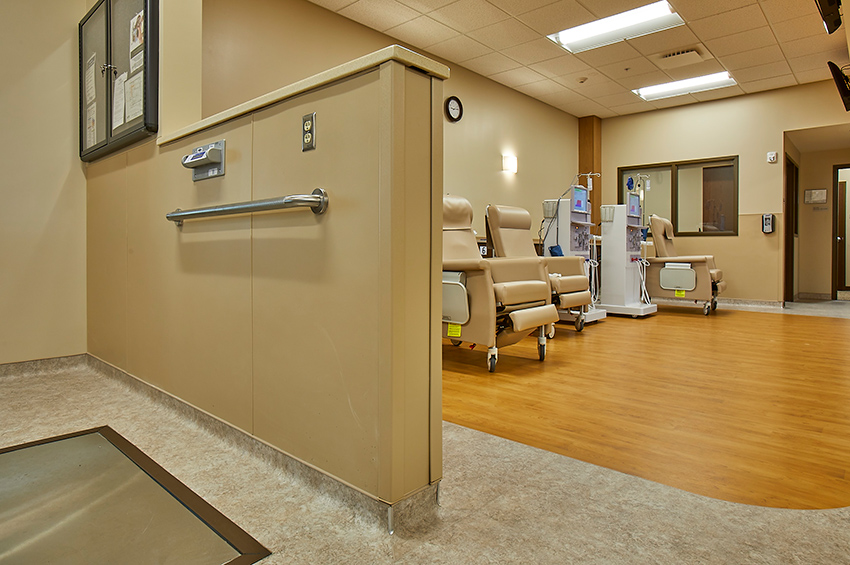
Photo courtesy of Inpro
Targeted Wall Protection products are designed to absorb impact and protect the underlying
wall. They protect finishes and designs, keeping high-use areas aesthetically pleasing and minimizing repairs.
Targeted Wall Protection is a set of specific products designed to absorb impact and protect the underlying wall.
These products cover only part of the wall, but function to provide a higher level of impact resistance. Examples
include corner guards and wall guards.
Wall Guards perform as their name implies: these products guard the wall. Sometimes wall guards are referred to as
Crash Rails. The two most-common forms are multi-component systems and single material systems. Wall guards are
designed to take impact dead on, into the face of guard. Cover materials include all extruded plastics, and some may
contribute to LEED credits. They offer long service life with durable cover and end caps, which can be replaced.
Corner Guards are considered to be the unsung heroes of interior protection. Corners in corridors are some of the
most vulnerable places in a building. Because corners are the outermost joint of the wall, their position makes them
highly susceptible to damage. Corner guards may stop above the base trim, or they may extend to the floor, which
also reinforces the wall base. The two most-common forms of corner guards are multi-component systems and single
material systems.
The common form of corner guard is surface mounted. It can have an aluminum or extruded plastic retainer. Covers can
come in a rainbow of colors, patterns, and woodgrains. Top caps finish the look of the guard and prevent dust and
debris from getting behind the guard.
Single-material systems can come in extruded plastic; metals, most often stainless steel; and heavy-duty materials
like rubber. Rubber is used mainly for the back of house, loading docks, and warehouses.
Most corner guards are affixed either mechanically with hardware or by adhesive. Single-material corner guards can
be installed with pressure-sensitive tape. Tape-on guards work best where abuse risk is low to moderate. While clear
polycarbonate guards are inexpensive and easy to mount, they are subject to breakage and can accumulate dust,
debris, and even insects. Extruded plastic corner guards come in various wing sizes and lengths, and various bull
nose angle types are available. Surface mount rubber corner guards withstand very heavy abuse and have a very long
life cycle. Rubber corner guards are also an excellent choice for service corridors with high traffic and higher
damage potential.
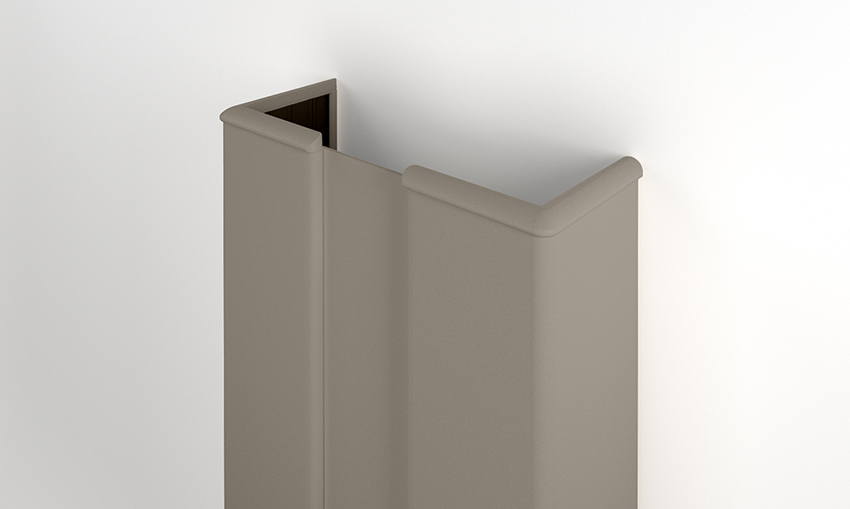
Photo courtesy of Inpro
New vinyl guards are the perfect example of performance meeting sustainable design, meeting an
aesthetically pleasing product.
The use and installation of flush mount corner guards is usually reserved for new construction or major renovation.
Flush mount corner guards are designed so that the metal bead “wings” of the corner guard rest along drywall, thus
allowing the plane of the corner guard to be flush with the wall, as opposed to surface mount guards that protrude.
Flush mount corner guards do have a variety of advantages. They provide high impact protection, generally from floor
to ceiling. The designs are available in various wings sizes and angles, and one-hour and two-hour fire rating is an
option. Flush mounts also offer a long life cycle, as covers may be changed to update colors.
Manufacturers have also introduced new corner guards for maximum coverage against damage that feature lower cost
vinyl retainers. With some of these products offering up to four times greater impact protection over a standard
aluminum retainer, performance is greatly increased. The new vinyl systems are easy to install, with mounting
hardware included, and are lightweight. Depending on manufacturer, this product contributes to the sustainable
design of a building and offers the opportunity for a project to obtain several Green Building Rating System
credits, including LEED and WELL. New vinyl guards are the perfect example of performance, meeting sustainable
design, meeting an aesthetically pleasing product.
Recycling: Capturing Sustainability at the End
The reason designers install door and wall protection products is to cut down on visible damage and keep surfaces
looking new. This translates into extending and preserving the life of selected materials and the structure as a
whole. Beyond the performance of door and wall protection products, sustainability from the very materials selected
can also be captured. Responsible product manufacturers are constantly looking for ways to reduce environmental
impact, whether through the manufacturing and recycling of products or through business practices. Product
transparency has increased dramatically through documentation such as Health Product Declarations (HPD),
Environmental Product Declarations (EPD), and Greenguard Gold Certificates. Gathering the information for these
documents also sheds light on the environmental aspects of products at various stages.
Instead of simply sending scrap to the landfills, manufacturers are increasingly able to reuse it in a way that
creates usable products with greater performance. Manufacturers enrolled in the Zero Waste by 2025 program are
repurposing internal scrap to contribute to that goal. Leading manufacturers are operating at almost an 80% overall
diversion rate based on production efficiencies, and internal recycling of PVC, metals, and comingled materials.
Take-back programs are evolving to engage the customer in product recycling. Manufacturers are creating programs
allowing customers to recycle scrap or removed product, preventing the materials from going to the landfill.
Depending on material, the recycled product is then able to be reground and turned into new product elements. Some
material producers, in addition to the environmental aspects of this program, incentivize customers who utilize this
program with a monetary credit back to their account. This system helps to build valuable relationships with
customers based on mutual benefits.
The select group of material suppliers and manufacturers is growing, representing truly exceptional companies that
are not only committed to going above and beyond, but are also committed to bringing about change in their industry,
region, or within their supply chain.
CONCLUSION
With sustainability’s rise to the forefront in architecture and construction, products and systems continue to
innovate to provide the architect, the design professional, and the client opportunities “to meet the needs of the
present without compromising the ability of future generations to meet their own needs.” The ability to be
sustainable continues to expand. Whether it be in implementing the latest design and analytical software, rethinking
exterior surfaces to allow for the utilization of rainfall and mitigation of floodwater, or recyclable products
which protect a building’s interior and extend its aesthetic and useful life, the quest for a more sustainable
future seems attainable.
Amanda Voss, MPP, is an author, editor, and policy analyst. Writing for multiple publications, she has also
served as the managing editor for Energy Design Update.






